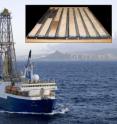Ancient global warming episode holds clues to future climate, UH Manoa researcher says
When scientists take Earth's temperature, they usually use thermometers. But when scientists want to figure out Earth's temperature in the past, they have to rely on other tools. One of these is deep-sea sediment cores (see Figure). Deep-sea sediments contain fossil remains of tiny marine creatures and other materials that sink to the ocean floor. Over millions of years, these materials pile up and build climate archives that tell stories about Earth's history. Today, scientists recover those archives during ocean drilling expeditions aboard research vessels such as the JOIDES Resolution (see Figure). Now a team of scientists, led by Richard Zeebe of the University of Hawai'i at Manoa's School of Ocean and Earth Science and Technology, has examined data from sediment cores from around the world to study an ancient global warming episode, known as the Paleocene-Eocene Thermal Maximum. This warming event occurred about 55 million years ago and provides important clues about what the future may hold. By studying the past, the researchers contribute to better forecasting the future – a principle once expressed by the English historian Edward Gibbon: "I know no way of judging of the future but by the past."
There is little doubt among scientists that the Earth is warming because of carbon dioxide emissions from human activities. But exactly how much the Earth will warm – say until the end of the 21st century – is still uncertain. In their study published in the journal Nature Geoscience, Zeebe and his team help to resolve the question by studying a possible analog in the past. Using sediment archives and theoretical tools, they provide estimates of the amount of carbon dioxide in the atmosphere during the warming episode 55 million years ago.
The team had to go back that far in time because this event may be the only one during the past 55 million years of similar scale and pace as the current human disruption. At that time, global surface temperatures rose by 5°C within a few thousand years. At nearly the same time, a large amount of carbon was released, probably from the dissociation of oceanic methane hydrates. By comparing the change in ancient temperature and carbon dioxide levels, Zeebe and his team provide clues about the magnitude of global warming during large and rapid increases of greenhouse gases.
What the team found was quite unexpected. Based on current knowledge about Earth's climate system, they expected a three- to eightfold increase in atmospheric carbon dioxide levels to explain the 5°C warming. Yet, they found only a less-than-twofold increase.
Zeebe, an oceanographer at UH Manoa, says: "We were pretty surprised that the increase in atmospheric carbon dioxide turned out to be so small. To explain the entire warming, you would need a whole lot more carbon."
The consequence is that other mechanisms must have considerably contributed to the warming 55 million years ago. Unfortunately, these mechanisms are unknown at present.
"There are a few ideas what may have contributed to the additional warming. But I don't think we fully understand these events of intense and rapid global warming," says Zeebe.
If the additional warming in the past was a response to rising carbon dioxide, then also future warming could be much stronger than anticipated. Undoubtedly, the Earth was a different place 55 million years ago and comparison with today's situation is imperfect. Nevertheless, the work of Zeebe and his co-workers suggests that the future climate could hold some surprises.
"By continuing to put these huge amounts of carbon dioxide in the atmosphere, we're gambling with climate and the outcome is still uncertain," Zeebe says.
Source: University of Hawaii at Manoa
Articles on the same topic
- 'Motion picture' of past warming paves way for snapshots of future climate changeThu, 16 Jul 2009, 18:26:15 UTC
- Global warming: Our best guess is likely wrongTue, 14 Jul 2009, 16:45:55 UTC
Other sources
- 'Motion picture' of past warming paves way for snapshots of future climate changefrom PhysorgThu, 16 Jul 2009, 19:49:18 UTC
- 'Motion Picture' of Past Warming Paves Way for Snapshots of Future Climate Changefrom Newswise - ScinewsThu, 16 Jul 2009, 18:42:15 UTC
- Global Warming: Scientists' Best Predictions May Be Wrongfrom Science DailyWed, 15 Jul 2009, 7:14:11 UTC
- Global warming: Our best guess is likely wrongfrom PhysorgTue, 14 Jul 2009, 18:14:14 UTC
- Global warming: Our best guess is likely wrongfrom Science BlogTue, 14 Jul 2009, 17:49:14 UTC
- Mystery mechanism drove global warming 55 million years agofrom PhysorgMon, 13 Jul 2009, 18:56:19 UTC
- Trapping Carbon Dioxide Or Switching To Nuclear Power Not Enough To Solve Global Warming Problem, Experts Sayfrom Science DailyMon, 13 Jul 2009, 14:21:10 UTC
